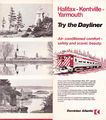Dominion Atlantic Railway Digital Preservation Initiative - Wiki
Use of this site is subject to our Terms & Conditions.
Grand Pre Park
Grand Pre Park, Nova Scotia
Description & History
A line of willow trees and an old well associated with the vanished Acadian village across the track from the Grand Pre Station station quickly became a scenic attraction for tourists attracted by Henry Wadsworth Longfellow's poem "Evangeline" which was set at Grand Pre. The Windsor & Annapolis Railway promoted the surrounding landscape to attract American tourists. In 1907 a Wolfville resident with Acadian roots, John Frederic Herbin, bought the land across from the station believed to be the site of the Acadian church so that it might be protected and built a small memorial cross.
Herbin sold the land to the DAR in 1917 on the condition that Acadians be involved in its preservation. The railway made major investments at the site hiring a landscape architect to work with the DAR's head gardener to create a large memorial garden at the site. In 1920 the Dominion Atlantic erected a statue of Evangeline created by the Canadian sculptor Louis-Philippe Hébert. The railway donated a piece of the land in the park to the Acadian community to build a memorial chapel in 1922. The chapel was built in June 1922 along with the Grand Pre Water Tower, which was built both to water the memorial gardens as well as provide water to locomotives.[1] A small memorial cross marking the believed location of the loading point for the Acadian Expulsion was installed beside the tracks east of Grand Pre at Horton Landing in August 1923.[2]A new picturesque, log-cabin style station was built on the north side of the tracks in 1925 connected to the park by landscaped paths. The church opened as a museum in 1930 jointly run by the Acadian community and the DAR. A tea room was added in the 1930s, run by Gladys Porter, the manager of the Kentville Station restaurant. After the decline in passenger travel in the 1950s, Gladys Porter campaigned to have the Canadian Parks Service take over the park and the DAR sold the memorial gardens to the Parks Service in 1957.
Gallery
Photographic postcard of Grand Pre circa 1915.
Cover of Highlights of Nova Scotia History showing the New Yorker passing the Grand Pre Park.
Article and photos of the construction of the Grand Pre Park memorial chapel and the Grand Pre Water Tower, "Memorial Building at Grand Pre" in The Acadian, June 9, 1922
Circuit camera shot of Evangeline statue in the memorial park with station and warehouses in the background, Aug. 16, 1922.
Detail of circuit camera shot of Evangeline statue in the parkwith the station, and warehouses in the background, including the Grand Pre Fruit Company Warehouse to the far left, Aug. 16, 1922.
Photograph of Grand Pre showing the Grand Pre memorial church; the Grand Pre Water Tower and apple warehouses, including the Grand Pre Fruit Company Warehouse at the far right, circa 1925.
Grand Pre, air view from the south with the Grand Pre Station, Water Tower and fruit warehouses with the memorial park behind, 1931.
Grand Pre air view from east with the Grand Pre Station, Water Tower and memorial park with Wolfville in distance, 1931.
Post card made from Air view of Grand Pre Station, Grand Pre Water Tower and Grand Pre Park, 1931.
Queen Annapolisa VI in the Apple Blossom Festival coronation ceremony at Grand Pre Park with the water tower, British Canadian Fruit Association warehouse and DAR Boxcar 1330 in work train, June 5, 1938.
Grand Pre memorial park entrance with DAR sign, 1941.
View of the memorial park Entrance. Date unknown.
RDC pulling into Grand Pre and the grounds of memorial park, circa 1973.
Grand Pre Park featured on cover to Dominion Atlantic Dayliner brochure June 17 to September 26, 1977.
References & Footnotes
- ↑ "Memorial Building at Grand Pre" in The Acadian, June 9, 1922
- ↑ The Acadian, July 1923, shared in Post by Chris Gertridge, July July 8, 2024










